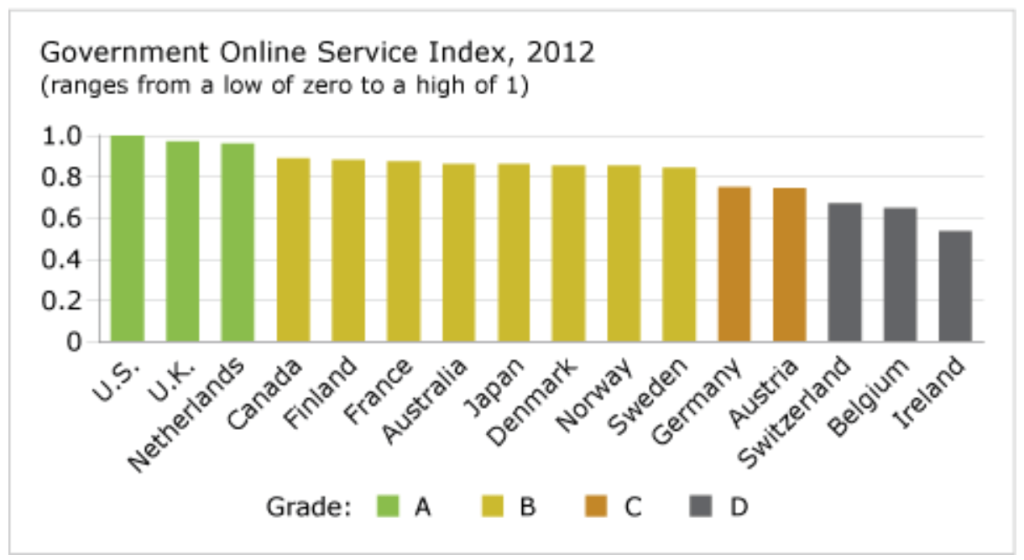Government Online Services Index
- Canada gets a “B” grade and ranks 4th out of 16 countries.
- By transforming the model of interaction between governments and the public, government online services can act as a catalyst for innovation.
- Canada’s relative weakness is the result of a poor score in one of the elements of index: engaging citizens in decision-making.

Why are government online services important to innovation?
The growing use of information technologies by government bodies and agencies to interact with citizens, businesses, and other levels of government has transformed government service delivery models and spurred innovation. Within the public sector, in terms of both information and services, citizens are “increasingly viewed as ‘active customers of public services’ with borrowed private sector concepts being applied to improve public sector governance systems.”1
Consistent with the model of viewing citizens as customers of government services, the earlier government-centric relationship has evolved to a citizen-centric one, where—at the highest form of evolution in this relationship—governments proactively solicit input from citizens, creating an environment that empowers citizens to be more involved with government activities.2
What does the online services index measure?
The online services index was developed by the United Nations to evaluate the scope and quality of government online services. The following websites were assessed for content and features, as well as tested for a minimal level of web content accessibility as described in the Web Content Accessibility Guidelines of the World Wide Web Consortium:3
- each country’s national website, including the national central portal, e-services portal and e-participation portal
- the websites of the related ministries of education, labour, social services, health, finance, and environment
The survey questionnaire had four sections that corresponded to the four stages of e-government development:4
- Stage 1: Emerging information services: Government websites provide basic and limited information on public policy, governance, laws, regulations, documentation, and types of government services provided. Citizens should be easily able to obtain information on what is new in the national government and ministries and can follow links to archived information.
- Stage 2: Enhanced information services: Government websites deliver enhanced one-way or simple two-way e-communications with their citizens, such as downloadable forms for services and applications.
- Stage 3: Transactional services: Government websites engage in two-way communication with their citizens, such as paying taxes and applying for ID cards, birth certificates, passports, and licence renewals.
- Stage 4: Connected services: At this most sophisticated level, the government is encouraging citizen participation in decision-making and is willing and able to involve the society in a two-way, open dialogue. At this stage, government has moved from a government-centric to a citizen-centric approach.
The scoring of individual countries’ performance within the four stages is independent of other categories. For example, a country can have a high score in stage 2 but a weak score in stage 3.
How are grades assigned for this report card?
The grading methodology for this report card is different from the How Canada Performs standard methodology. An “A” grade was assigned to an index value of 0.9 or more; a “B” to an index value of 0.8 to 0.899; a “C” to an index value of 0.7 to 0.799; and a “D” to an index value below 0.7.
How does Canada’s performance compare to its peers?
Canada places fourth overall and receives a “B” grade. The top three countries—the U.S., the U.K., and the Netherlands—all receive “A”s. Canada’s rankings on each of the four stages are as follows:
- Stage 1: Canada receives a perfect grade, along with 12 other peer countries. The exceptions are Ireland, Germany, and Sweden.
- Stage 2: Canada scored lowest on this stage, placing eighth overall, behind the U.K., U.S., Finland, Sweden, Netherlands, Switzerland, and Denmark.
- Stage 3: Canada places third behind the U.S. and France.
- Stage 4: Canada’s ranks seventh, behind the Netherlands, U.S., U.K., Australia, Japan, and Norway.
Who are the leaders in this report card?
The overall country rankings are led by the U.S., which performs uniformly well on all four stages of e-government development. The performance of the Netherlands—which places third, after the U.K.—is held back by a poor ranking on stage 3.
What can Canada do to improve its grade?
Canada is weak on stages 2 and 4 services. Stage 2 assesses whether the government provides “greater public policy and governance sources of current and archived information.”5
Stage 4 assesses whether the government engages in “participatory deliberative decision-making and is willing and able to involve the society in a two-way open dialogue.”6
A higher grade on this report card would likely push Canada’s ranking into the top three.
Footnotes
1 United Nations, E-Government Survey: E-Government for the People (New York: United Nations, 2012), 10.
2 Ibid., 124.
3 Ibid., 120.
4 Ibid.
5 Ibid.
6 Ibid.

